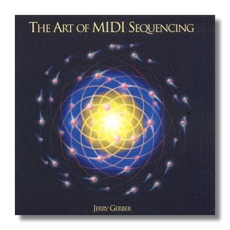
The Internet's Premier Classical Music Source
Related Links
- Gerber Reviews
- Latest Reviews
- More Reviews
-
By Composer
-
Collections
DVD & Blu-ray
Books
Concert Reviews
Articles/Interviews
Software
Audio
Search Amazon
Recommended Links
Site News
 CD Review
CD Review
Jerry Gerber

The Art of MIDI Sequencing
- Symphony #5 (2002)
- Essay for Virtual Orchestra (2001)
Ottava Records 03-007 47:09
Summary for the Busy Executive: Music by Fabergé.
Jerry Gerber, virtuoso MIDI-meister, gets us to drop our jaws in astonishment yet again. Most of us habitually think of MIDI files as somewhat crude boops and blats or the sound of a piano played by dead people in a totally sterile room. I've used MIDI technology to help me write, to let me hear better what I imagined, but I'd never let anyone else hear it. Gerber's MIDI files, to a great extent, are indeed the final product. Comparing my files to his is comparing stick men to a Titian. Gerber gives us a vast sonic stage with sounds – not life-like exactly – resembling, rather, the Berlin Philharmonic, the Cleveland Orchestra, and the Chicago Symphony. Yet the only human in the entire enterprise is Gerber himself. He strikes me as a pioneer. As symphony orchestras die off, as fewer and fewer people turn to classical music out of choice, as audiences and repertoire ossify – in short, as resources become scarcer for the amount of new and not-so-new music out there – composers will probably have to join Gerber's enterprise, radicals and conservatives alike, just to hear what they have written and to make a basic effort to distribute the works to others.
Aside from understanding his samplers, sound generators, Sibelius software, and mixing boards inside out, Gerber is also a composer who knows his business. Much of his success comes from recognizing the limits as well as the advantages of his medium and writing music which hides the first behind the second. The variety of sounds, the ability to perfect balance, the sharpness of electronic rhythm counterbalance the inflexibility of tempo (an electronic Mengelberg, for example, isn't yet possible), the stiffness and crudity of the phrase, and the independent contribution of the individual player. If you can't get a Pierre Fournier subtlety of phrase, you can throw in a lot of interesting lines at once and the ear will probably pass over it. Also, Gerber goes as far as anybody I've heard in "humanizing" the sequencer, of creating the illusion of, say, Stokowski at the helm.
I don't know the extent to which Gerber's music can be performed by humans, but it certainly resembles traditional music, rather than the music from Nebulon-5. One can judge it accordingly. The ambitious work is the fifth symphony. I've heard his fourth symphony and the latest one represents both an advance and a retreat. On the one hand, he has expanded his musical and technical resources. There's a lot more different kinds of music going on – Hovhaness-like evocations of the Far East, a rapprochement with classic serialism, Coplandian Americana, and John Williams movie scores, among other things – than in the earlier symphony. Gerber has expanded his basic eclecticism. On the other hand, he has difficulty holding it all together convincingly. The symphony follows a traditional architecture – allegro moderato, slow movement, scherzo, and allegro finale. Despite the high quality of all the movements, only the second and fourth seem to belong to the same work. Furthermore, the first movement is really a bunch of beautiful episodes, rather than a sustained symphonic argument. The same discombobulation afflicted the finale of the fourth symphony, but to a lesser degree. The second movement, a bittersweet lament that could have accompanied the last quarter-hour of Spielberg's A. I., wins my admiration the most of the four. It's not motifically all that tight, but it carries you along. The third movement is unquestionably the most fun. It's a bit at odds with its title ("Joy of Cannabis") – with a bounding energy one doesn't associate with stoners. The only thing marijuana ever did for me was increase my tendency to withdraw from people. And it raked my throat, besides. Ah, youth! My only objection to it is that, as I've said, it doesn't seem to belong to this work, but to another. We haven't heard sounds this Rodeo -ish before (or after), and while not unwelcome, it does come across as an isolated jolt. Nevertheless, it's the most coherent, easiest-to-follow movement of symphony.
The liner notes make a big deal of the fact that some of the music of the finale follows dodecaphonic practice. To me, this is like praising a work for being in a major key. It's simply one element of many. Gerber's job, however, is to relate it to the rest of the movement, which he does to a large extent, showing affinities with Middle Eastern melisma. Rhetorically, the movement unfolds episodically, but Gerber provides enough thematic glue – as he does not in the opening allegro – to make the kaleidoscopic shifts convincing. This is a virtuoso movement, both in the composing and in the MIDI manipulation.
The Essay for Virtual Orchestra works on a less ambitious, but lovely plane, nevertheless. It reminds me a bit of the opening movement to Dvořák's Serenade for Strings, and that's nothing to sneer at.
In all, this is primarily attractive music that indulges you – music of the senses. That's fine with me.
Copyright © 2003, Steve Schwartz




















